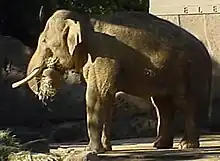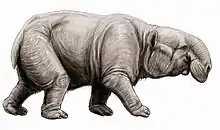| Elephas Temporal range: Pliocene to present | |
|---|---|
 | |
| Asian elephant | |
| Scientific classification | |
| Domain: | Eukaryota |
| Kingdom: | Animalia |
| Phylum: | Chordata |
| Class: | Mammalia |
| Order: | Proboscidea |
| Family: | Elephantidae |
| Tribe: | Elephantini |
| Genus: | Elephas Linnaeus, 1758 |
| Type species | |
| Elephas maximus | |
| Species | |
|
8; see text | |
| Synonyms | |
|
Hypselephas | |
Elephas is one of two surviving genera in the family of elephants, Elephantidae, with one surviving species, the Asian elephant, Elephas maximus.[1] Several extinct species have been identified as belonging to the genus, extending back to the Pliocene era.
Description

Species of Elephas have distinct bossing of the parieto-occipital region of the skull. The premaxillae bones containing the tusks are tapered.[2]
Evolutionary history
Asian elephants share a closer common ancestry with mammoths (genus Mammuthus) than they do with African elephants (Loxodonta).[3] The oldest species attributed to the genus are known from the early-mid Pliocene (5–4.2 million years ago) of Africa, like Elephas ekorensis,[4] though the attribution of this species to Elephas has been questioned.[5] The oldest record of the genus outside of Africa is Elephas planifrons which is known from the Late Pliocene of the Indian subcontinent, around 3.6 million years ago.[6] However, the placement of Elephas planifrons within the genus has also been questioned.[7] The earliest fossils of the ancestor of the modern Asian elephant, Elephas hysudricus date to the beginning of the Pleistocene, around 2.6 million years ago, with remains found on the Indian subcontinent.[8] Modern Asian elephants had evolved from E. hysrudicus by the Late Pleistocene.[9]
Taxonomy
The scientific name Elephas was proposed by Carl Linnaeus in 1758 who described the genus and an elephant from Ceylon.[10] The genus is assigned to the proboscidean family Elephantidae and is made up of one living and seven extinct species:[11]
- Elephas maximus – Asian elephant[1]
- Elephas maximus indicus – Indian elephant
- Elephas maximus maximus – Sri Lankan elephant
- Elephas maximus sumatranus – Sumatran elephant
- Elephas maximus borneensis – Borneo elephant, proposed but not yet recognized as valid[12]
The following Asian elephants were proposed as extinct subspecies, but are now considered synonymous with the Indian elephant:[1]
- Elephas maximus sondaicus – Javan elephant †
- Elephas maximus rubridens – Chinese elephant †
- Elephas maximus asurus – Syrian elephant †
The following Elephas species are extinct:
- Elephas beyeri – dwarf elephant species described from fossil remains found in 1911 in Luzon, the Philippines by von Königswald[13]
- Elephas ekorensis – described from the Kubi Algi Formation, Turkana, Kenya,[11] dating to the Early Pliocene, one of the oldest species of the genus.[14]
- Elephas hysudricus – described from fossil remains found in the Siwalik hills by Falconer and Cautley, 1845,[15] thought to be the ancestor of the living Asian elephant.[16]
- Elephas hysudrindicus – a fossil elephant of the Pleistocene of Java and different from Elephas maximus sondaicus[17]
- Elephas planifrons - one of the oldest species, known from the Late Pliocene-Early Pleistocene of the Indian subcontinent.[18]
- Elephas platycephalus a species sometimes recognised from the Pleistocene of India
- Elephas kiangnanensis a species sometimes recognised from the Early-Middle Pleistocene of China.[19][20]
While formerly assigned to this genus, Elephas recki, the straight-tusked elephant E. antiquus and the dwarf elephants E. falconeri and E. cypriotes are now placed in the separate genus Palaeoloxodon, which is more closely related to African elephants.[21] However, some material assigned to Elephas recki may be closely related to true Elephas.[22] "Elephas" celebensis is now placed in Stegoloxodon.[23]
References
- 1 2 3 Shoshani, J. (2005). "Genus Elephas". In Wilson, D.E.; Reeder, D.M (eds.). Mammal Species of the World: A Taxonomic and Geographic Reference (3rd ed.). Johns Hopkins University Press. p. 90. ISBN 978-0-8018-8221-0. OCLC 62265494.
- ↑ Zhang, Hanwen; Pape, Thomas; Lister, Adrian M. (2018-01-02). "On the type material of Elephas hysudrindicus Dubois, 1908 (Mammalia, Proboscidea)". Journal of Vertebrate Paleontology. 38 (1): e1425211. doi:10.1080/02724634.2017.1425211. ISSN 0272-4634.
- ↑ Fleischer, R. C.; Perry, E. A.; Muralidharan, K.; Stevens, E. E. & Wemmer, C. M. (2001). "Phylogeography of the Asian Elephant (Elephas maximus) based on mitochondrial DNA". Evolution. 55 (9): 1882–1892. doi:10.1111/j.0014-3820.2001.tb00837.x. PMID 11681743.
- ↑ Sanders, William J.; Haile-Selassie, Yohannes (June 2012). "A New Assemblage of Mid-Pliocene Proboscideans from the Woranso-Mille Area, Afar Region, Ethiopia: Taxonomic, Evolutionary, and Paleoecological Considerations". Journal of Mammalian Evolution. 19 (2): 105–128. doi:10.1007/s10914-011-9181-y. ISSN 1064-7554. S2CID 254703858.
- ↑ Sanders, William J. (March 2020). "Proboscidea from Kanapoi, Kenya". Journal of Human Evolution. 140: 102547. doi:10.1016/j.jhevol.2018.10.013. PMID 30745193. S2CID 73451588.
- ↑ Iannucci, Alessio; Sardella, Raffaele (2023-02-28). "What Does the "Elephant-Equus" Event Mean Today? Reflections on Mammal Dispersal Events around the Pliocene-Pleistocene Boundary and the Flexible Ambiguity of Biochronology". Quaternary. 6 (1): 16. doi:10.3390/quat6010016. hdl:11573/1680082. ISSN 2571-550X.
- ↑ H. Zhang Elephas recki: the wastebasket? 66th Symposium of Vertebrate Palaeontology and Comparative Anatomy, Manchester. (2018)
- ↑ Lister, Adrian M.; Dirks, Wendy; Assaf, Amnon; Chazan, Michael; Goldberg, Paul; Applbaum, Yaakov H.; Greenbaum, Nathalie; Horwitz, Liora Kolska (September 2013). "New fossil remains of Elephas from the southern Levant: Implications for the evolutionary history of the Asian elephant". Palaeogeography, Palaeoclimatology, Palaeoecology. 386: 119–130. Bibcode:2013PPP...386..119L. doi:10.1016/j.palaeo.2013.05.013.
- ↑ Ma, Jiao; Wang, Yuan; Jin, Changzhu; Hu, Yaowu; Bocherens, Hervé (May 2019). "Ecological flexibility and differential survival of Pleistocene Stegodon orientalis and Elephas maximus in mainland southeast Asia revealed by stable isotope (C, O) analysis". Quaternary Science Reviews. 212: 33–44. Bibcode:2019QSRv..212...33M. doi:10.1016/j.quascirev.2019.03.021. S2CID 135056116.
- ↑ Linnaei, C. (1760). "Elephas maximus". Caroli Linnæi Systema naturæ per regna tria naturæ, secundum classes, ordines, genera, species, cum characteribus, differentiis, synonymis, locis. Vol. Tomus I. Halae Magdeburgicae: Ioannes Ioachimus Langius. p. 33.
- 1 2 Maglio, V.J. (1973). "Origin and evolution of the Elephantidae". Transactions of the American Philosophical Society, Philadelphia Volume 63. American Philosophical Society, Philadelphia, pp. 149
- ↑ Fernando, P., Vidya, T.N.C., Payne, J., Stuewe, M., Davison, G., et al. (2003). DNA Analysis Indicates That Asian Elephants Are Native to Borneo and Are Therefore a High Priority for Conservation. PLoS Biol 1 (#1): e6
- ↑ Von Königswald, G.H.R. (1956). Fossil mammals from the Philippines. National Research Council of the Philippines, Manila
- ↑ Sanders, William J.; Haile-Selassie, Yohannes (June 2012). "A New Assemblage of Mid-Pliocene Proboscideans from the Woranso-Mille Area, Afar Region, Ethiopia: Taxonomic, Evolutionary, and Paleoecological Considerations". Journal of Mammalian Evolution. 19 (2): 105–128. doi:10.1007/s10914-011-9181-y. ISSN 1064-7554. S2CID 254703858.
- ↑ Falconer, H. & Cautley, P. T. (1846). Fauna Antiqua Sivalensis, Being the Fossil Zoology of the Sewalik Hills. Smith, Elder & Company, London, pp. 64.
- ↑ Lister, Adrian M.; Dirks, Wendy; Assaf, Amnon; Chazan, Michael; Goldberg, Paul; Applbaum, Yaakov H.; Greenbaum, Nathalie; Horwitz, Liora Kolska (September 2013). "New fossil remains of Elephas from the southern Levant: Implications for the evolutionary history of the Asian elephant". Palaeogeography, Palaeoclimatology, Palaeoecology. 386: 119–130. Bibcode:2013PPP...386..119L. doi:10.1016/j.palaeo.2013.05.013.
- ↑ Hooijer, D. A. (1955). Fossil Proboscidea from the Malay Archipelago and the Punjab. Zoologische Verhandelingen, 28 (#1): 1–146.
- ↑ Iannucci, Alessio; Sardella, Raffaele (28 February 2023). "What Does the "Elephant-Equus" Event Mean Today? Reflections on Mammal Dispersal Events around the Pliocene-Pleistocene Boundary and the Flexible Ambiguity of Biochronology". Quaternary. 6 (1): 16. doi:10.3390/quat6010016. hdl:11573/1680082. ISSN 2571-550X.
- ↑ Zhang, Hanwen; Wang, Yuan; Janis, Christine M.; Goodall, Robert H.; Purnell, Mark A. (July 2017). "An examination of feeding ecology in Pleistocene proboscideans from southern China ( Sinomastodon , Stegodon , Elephas ), by means of dental microwear texture analysis". Quaternary International. 445: 60–70. Bibcode:2017QuInt.445...60Z. doi:10.1016/j.quaint.2016.07.011. hdl:1983/4f6a743a-7b6d-47c8-a56a-fee7e2c515df.
- ↑ Haowen Tong & M. Patou-Mathis. (2003). Mammoth and other proboscideans in China during the Late Pleistocene. Deinsea, 9(1), 421–428.
- ↑ Palkopoulou, Eleftheria; Lipson, Mark; Mallick, Swapan; Nielsen, Svend; Rohland, Nadin; Baleka, Sina; Karpinski, Emil; Ivancevic, Atma M.; To, Thu-Hien; Kortschak, R. Daniel; Raison, Joy M. (2018-03-13). "A comprehensive genomic history of extinct and living elephants". Proceedings of the National Academy of Sciences. 115 (11): E2566–E2574. Bibcode:2018PNAS..115E2566P. doi:10.1073/pnas.1720554115. ISSN 0027-8424. PMC 5856550. PMID 29483247.
- ↑ Sanders, William J. (2023-07-07). Evolution and Fossil Record of African Proboscidea (1 ed.). Boca Raton: CRC Press. pp. 267–293. doi:10.1201/b20016. ISBN 978-1-315-11891-8.
- ↑ Markov, Georgi N.; Saegusa, Haruo (2008-09-01). "On the validity of Stegoloxodon Kretzoi, 1950 (Mammalia: Proboscidea)". Zootaxa. 1861 (1): 55. doi:10.11646/zootaxa.1861.1.5. ISSN 1175-5334.


